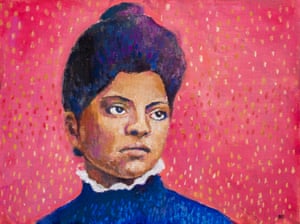How a grieving artist 'gathered strength' from painting groundbreaking women
In her set of paintings, titled Groundbreaking Girls, artist Allison
Adams found inspiration from influential women throughout history after
the death of her husband
Marie
Curie was the first woman to win the Nobel prize for physics. Frida
Kahlo was a pioneering Mexican artist. And the ballet dancer Janet
Collins was one of the first African Americans to take the stage in the
1950s. Together, these women broke barriers and to celebrate their
legacies, an artist in California has painted roughly 200 portraits of
them and other groundbreaking heroines – from suffragists to civil
rights activists and gospel singers – as part of an upcoming exhibit at
the Women’s Museum of California, entitled Groundbreaking Girls.
The artist, Allison Adams, will present about 40 selected portraits of influential women through history in an exhibit opening 1 February.“When I start saying to myself ‘I can’t do this single parenting thing, I can’t make it as an artist, I can’t, I can’t,’ these women’s stories helped me,” said Adams. “I wanted to educate people to that spirit, which is what we have access to as humans and as women.”
It all started in 2016, when Adams’s husband died tragically after surviving a car crash. “I was in a place where I felt the need to find inspiration,” said Adams, “so I started reading more about Eleanor Roosevelt’s life and I had this vision of sharing stories like hers to remind people we come from this legacy of amazing people we aren’t taught about very much.”
She painted her first portrait of Roosevelt, who is remembered as the longest-serving first lady of the US and is recognized for drafting the Universal Declaration of Human Rights in 1948. “Eleanor had a remarkable spirit of confidence and helping others,” she said. “It lifted me out of my funk, I thought ‘I’m going to paint her, I want that voice in my life.’”
Adams continued to paint portraits of women – all of whom had something in common: “I started looking for stories of women who overcame things,” she said.
Painting the series was a cathartic process for Adams, who was grieving. “It’s hard to talk about it without getting personal,” she said. “I was in a pretty dark place after losing my husband, it was shortly after the election in 2016 and everything was falling apart for me.”
The series features a portrait of the Maryland abolitionist Harriet Tubman, who was born into slavery and saved thousands of slaves by pioneering the Underground Railroad.
“I knew her from history class, but I never noticed the courage she had,” said Adams. “She is a voice in my mind when I’m feeling insecure, she overcame so much and didn’t let anything stop her.”

“These women, whether we know about them or not, all had to overcome something major; for me, that was life-changing and what I wanted to share,” said Adams. “A lot of them came from a hard place. I gathered strength from that.”
“I feel like they want to have their stories told and I am lucky enough to share them,” she adds.
She has also painted portraits of American artist Georgia O’Keeffe, a 20th-century pioneer of feminist art, as well as Lee Krasner, a painter who was the wife of Jackson Pollock, the alcoholic artist who had highly publicized love affairs with several women including Peggy Guggenheim. “When her husband died, she protected his estate and sold his work to museums and got more money for his pieces than any other abstract expressionist,” said Adams. “She did a lot for the art world.”
As New York City works towards getting more monuments to women up in a city that has just five statues of women in a city of 150 monuments, and with the ongoing sexual assault allegations as a result of the #MeToo and Time’s Up movements, now is the appropriate time to host this exhibit. “Women’s stories and justice are important now,” said the artist. “It’s exciting to make it during this time.”
When she paints them, Adams – a former actor – says she gets into their character, much like an actor would. “There is a sense of trying to get into their heads,” she said. “Their spirits are not gone, we can live by their words.”
It’s also a critical time to show these paintings given the eradication of certain women from some history classes. In the fall, the Texas board of education voted to remove former first lady Hillary Clinton and deaf-blind activist Helen Keller, both of whom ranked low for their historical significance, from the school curriculum.
“That worries me,” said Adams. “I have a duty to share and protect these stories.”
As the mother of a young daughter, Adams is concerned for the next generation of young women, and future generations to come. “There’s a lot of pushback of people trying to put women back in their place,” she said. “I am trying to keep these stories alive longer.”
Comments
Post a Comment